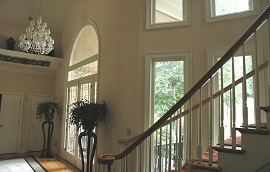Many homeowners are concerned with increasing the energy efficiency of their properties. Unfortunately, air leaks can easily compromise any efforts you have made to reduce your energy usage. Air leaks can force your HVAC systems to work harder and will allow your conditioned air to escape, costing you more to try and achieve your preferred comfort levels. So, here are some simple ways to determine if you have any air leaks in your home.
The most obvious and frequent leaks are due to drafts coming from doors or windows, but they can still be easily overlooked. Begin by checking your doors and windows to see if you can see light between the frame and door. These gaps should be sealed with weather stripping or caulk to eliminate the leaks that are wasting energy.
The next step is to walk around your home looking for any gaps or cracks. Take a logical approach walking through each room and pay particular attention to baseboards, fireplaces, electrical outlets, light switches, utility service entrances, vents, fans and attic doors.
A good technique is to use a lit candle to inspect these potential problem areas. The flame will flicker if there is any air movement and highlight even a small leak. You can then investigate the area more thoroughly to determine the underlying issue.
The type of air leak you detect will determine the best approach to rectify the situation. The Department of Energy does provide leak sealing tips, so you can check the best methods to reduce your energy wastage. In many cases, basic DIY skills are all that is needed to correct the problem.
Outside the Home:
It can be a little more tricky to detect leaks outside your home, but it is still worth checking for gaps, cracks or holes around exterior corners, near outdoor faucets and the property foundation. Ideally, all siding and surfaces should correctly match up with no gaps to ensure that there are no possible air leaks that are not visible from inside the home. These types of gaps can cause cold or hot spots when you are running your HVAC system that can make certain areas of your home uncomfortable. While you may only notice a slight difference in temperature inside, a gap, hole or crack may be immediately obvious outside.
If you do find any signs of air leaks outside your home, you may need help from a licensed contractor to correct the problem. It is always worth checking whether there is an underlying cause for any cracks or gaps as it could be a sign of a larger issue.
Consider a Home Energy Survey:
If you are serious about saving energy, you may want to consider a home energy survey. An experienced professional can assess your HVAC system and other potential problem areas to detect any major sources of energy loss within your home. They can also guide you through the best ways to correct them and boost the energy efficiency of your home.

